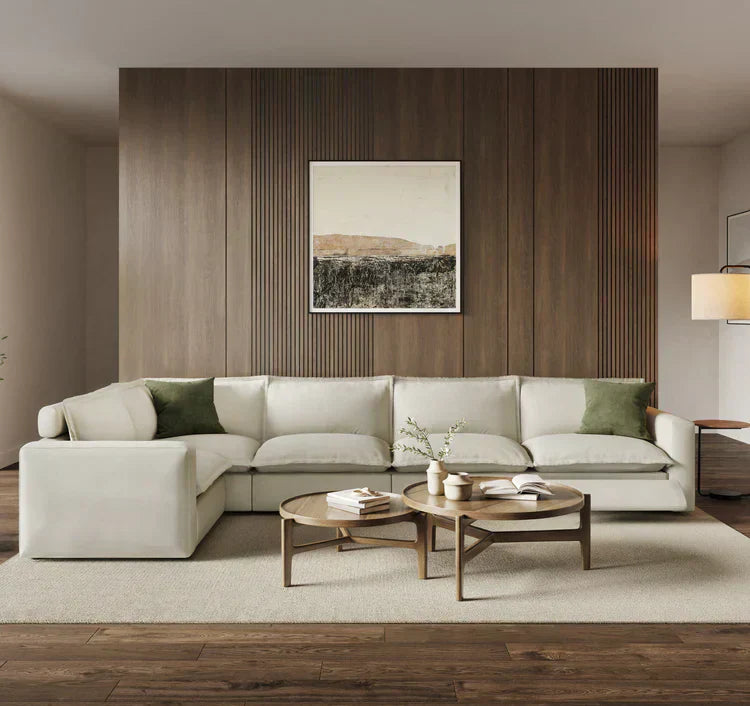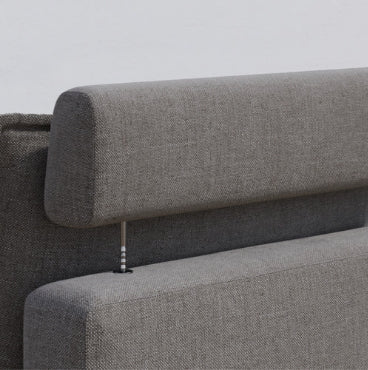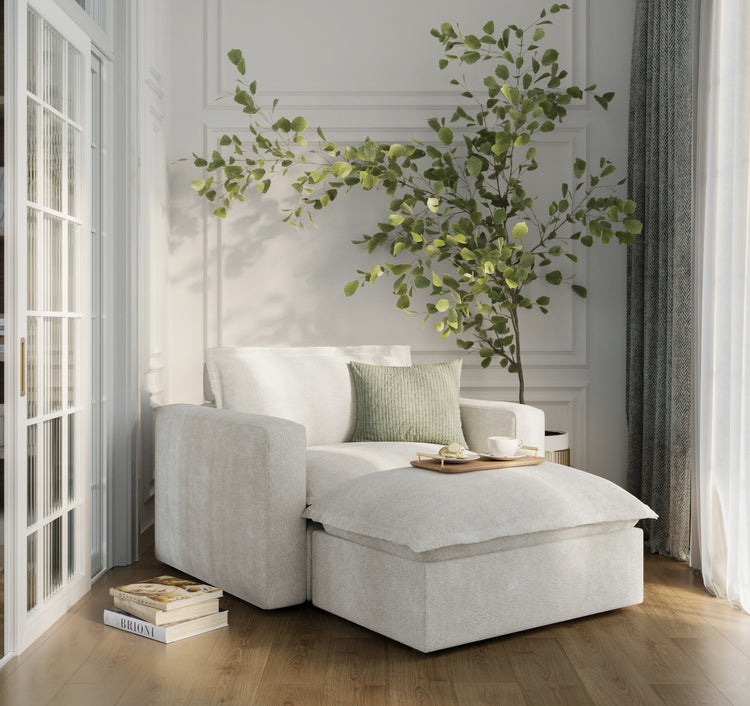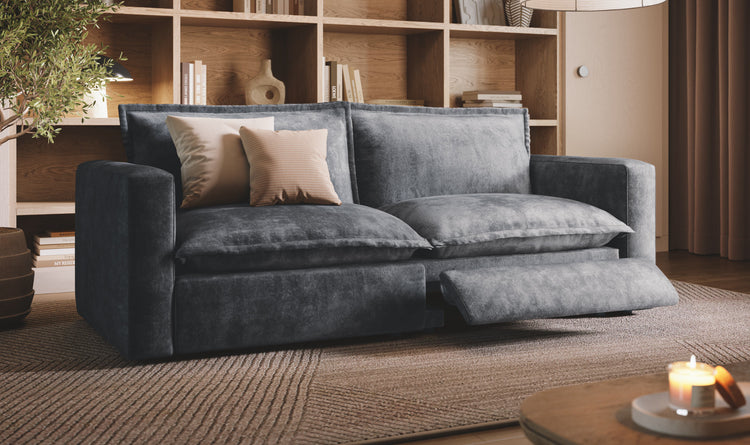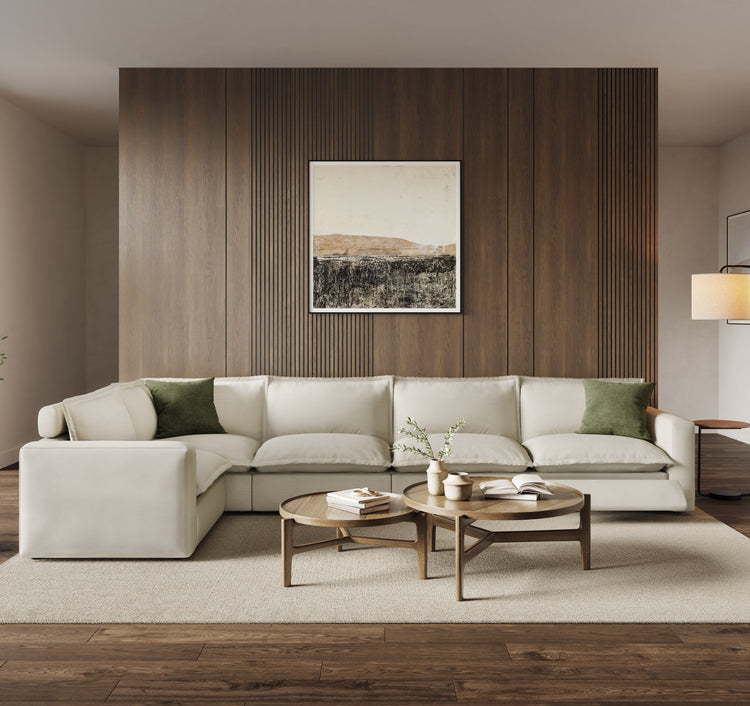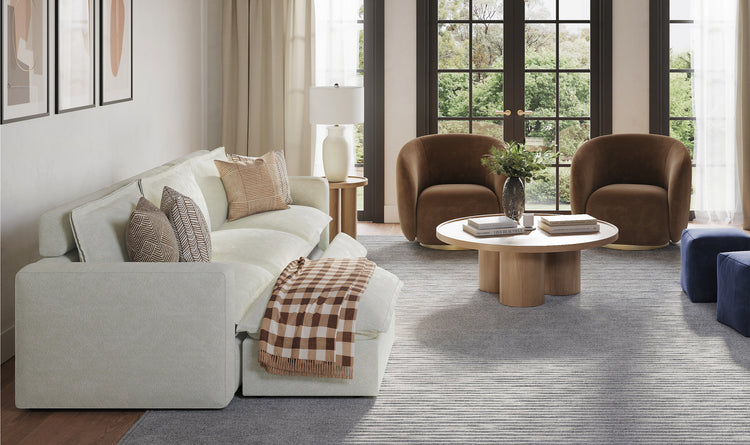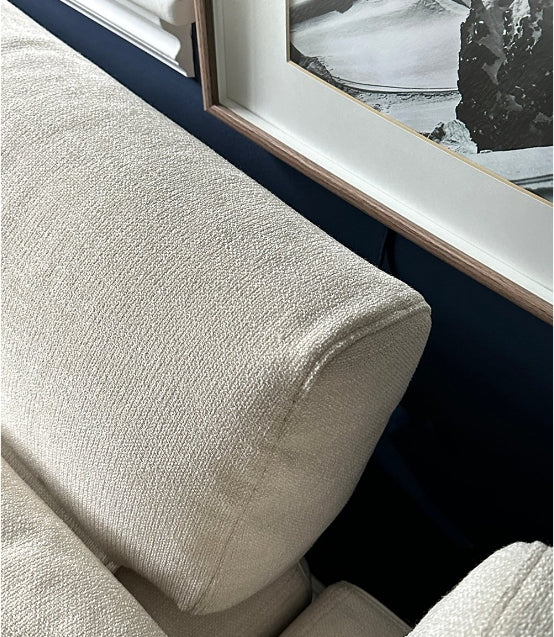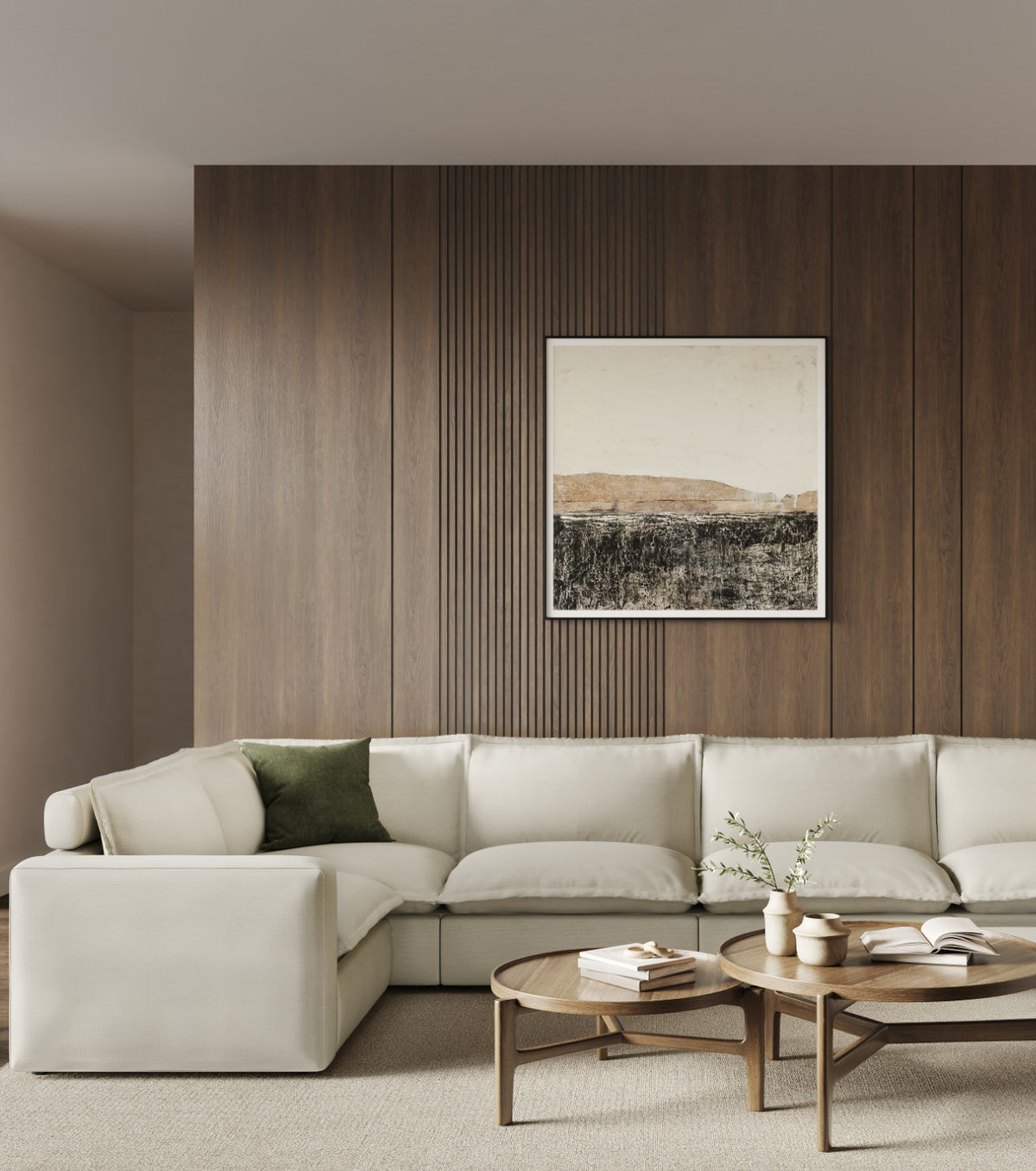Have you ever bought a new couch only to watch it get stuck in your doorway? This common problem ruins the excitement of new furniture. Taking a few simple measurements before you buy can prevent this hassle. We'll show you what to measure in your home and how to check couch sizes so your new furniture actually makes it inside, saving you money and time.
Why Should You Measure Before Buying a Sofa?
Taking measurements before ordering a sofa prevents costly mistakes and frustrating delivery problems. Most furniture stores charge restocking fees and return shipping costs that can add up quickly when a sofa doesn't fit through the doorframe.
Return Fees Add Up Fast
When a sofa doesn't fit through your door, most retailers charge restocking fees between 15-25% of the purchase price. You'll also pay return shipping costs ranging from $100-$300 depending on the size and distance. These unexpected expenses can turn a $1,000 sofa purchase into a $1,300+ mistake.
Delivery Problems Are Frustrating
Nothing feels worse than waiting weeks for your new sofa only to watch helplessly as delivery workers try every angle to get it through your door. Many customers report this as one of their most stressful home furnishing experiences, especially when they've already gotten rid of their old furniture.
You'll Wait Weeks for a Replacement Sofa
After a failed delivery, you'll face another 4-8 week wait for a replacement. This means sitting on folding chairs or the floor while you wait for the new furniture to arrive. During busy seasons like after holidays, these wait times can stretch even longer.
Taking just fifteen minutes to measure your doorways can save you hundreds of dollars and weeks of frustration. The simple steps in this guide will help make sure your new sofa arrives without problems. Don't let your excitement for new furniture turn into disappointment – grab a tape measure before you shop.

What Measurements Do You Need Before Ordering a Sofa?
After seeing how costly and frustrating delivery problems can be, it's time to grab your tape measure. Taking the right measurements now will save you from those return fees and delivery headaches later.
-
Measure Every Doorway Your Sofa Will Go Through: Take note of the width and height of every doorway your sofa must pass through. This would include your front door, apartment door, and any interior doors that lead to the room. Remove hinges from doors if need be to gain extra inches of clearance. Standard doorways are 30-36 inches wide, though older homes and apartments typically have smaller openings.
-
Check Hallways and Corners for Tight Spots: Measure the width of all hallways through which the sofa will travel. Pay special attention to the narrow corners the sofa will need to navigate. Measure the width of the hallway at the narrowest spot and note any obstacles like light fixtures or wall decorations that will encroach on clearance.
-
Measure Stairs and Landings If Moving Upstairs: For multi-story homes, measure the width of your staircase and the ceiling height over each step. Measure the landing space also where the sofa might have to turn. Spiral staircases and stairs with tight turns are usually the most troublesome for sofa delivery.
-
Know Your Elevator Size Before Delivery Day: If your home has an elevator, measure its interior height, width, and depth. Also measure the elevator door opening, as it's often narrower than the interior. Don't forget to check weight limits and reserve the elevator with building management on delivery day.
-
Leave Enough Walking Space in Your Room: Measure the room where the sofa will be placed, taking into account doorways, windows, and other furniture locations. Leave at least 30 inches of walking room around the sofa. Think about the use of the room and traffic flow to avoid the sofa blocking natural paths.
-
Write Down All Measurements as You Go: Use a metal tape measure for accuracy and take all measurements as you proceed. Photograph problem areas to illustrate to sales staff. Measure twice to confirm your measurements, and put your measurements on your phone so that you have them while shopping.
How to Read Sofa Dimensions Correctly
You've measured your home, but what about those sofa dimensions? Retailers list measurements that can be confusing if you don't know what you're looking at. Let's decode these numbers so you can confidently pick a sofa that will fit through all those doorways you measured.
What Each Measurement Means
Width is from arm to arm and is typically the longest dimension. Depth is from the front to the back of the seat. Height is from floor to top, usually the back cushions or frame. Diagonal depth—from the bottom back corner to the top front—is particularly relevant for doorways, as it indicates whether a tilted sofa will fit through. Too many people neglect these important measurements and have delivery problems.
Making Sense of Furniture Dimension Charts
Furniture retailers list dimensions differently. Some include the legs in height measurements while others don't. Look for "overall dimensions" for the most accurate numbers. Pay attention to whether measurements are listed as width × depth × height or in a different order. Always check if the dimensions refer to the assembled piece or shipping box.
Common Sofa Styles and Their Sizes
Average three-seat sofas generally measure 85-130 inches wide, 32-40 inches deep, and 30-38 inches tall. Loveseats are narrower at 58-90 inches, so they'll fit well in small rooms. Sleeper sofas are roughly the same size as regular sofas when closed, but remember that you'll have approximately 80-90 inches of free space in front when opened up. Jotting down these dimensions can be useful if you're going shopping.
Options for Small Spaces

If you are worried about tight spaces, consider these options: Apartment sofas (72-80 inches wide) are comfortable seating that takes up less space. Sofas with detachable legs can give you 3-5 additional inches at the time of delivery, which may be exactly what you need in a thin hallway. Modular sofas arrive in separate pieces that are less awkward to handle and can be rearranged in multiple configurations. Some create "knock-down" sofas which are specially designed to be small and space-friendly—these are portable and can be unassembled at home and reassembled in order to prevent delivery trouble.
How to Use the "Pivot Method" to Get Your Sofa Inside
With your measurements in hand, there's one more strategy to master before ordering: the pivot technique. This tried-and-true delivery method has saved countless sofas from being returned when doorways seem too narrow, and knowing how to calculate it can give you peace of mind before purchase.
What Is the Pivot Method?
Before you buy a sofa, there's one more trick to know: the pivot method. This simple technique helps delivery teams get sofas through doorways that seem too narrow. Understanding how it works can save you from returning furniture that won't fit.
How Pivoting Works
The pivot method means turning the sofa vertically to fit through doorways. Delivery people stand the sofa on one arm, then rotate it through the doorway at an angle before setting it down inside. This works because a sofa's diagonal measurement is often smaller than its width or height.
Checking If Pivoting Will Work
To see if pivoting will work in your home, you need to find the sofa's diagonal depth. Measure the height (floor to top of back) and the depth (front to back). Then use this simple math: √(height² + depth²) = diagonal measurement. If this number is less than your doorway width, the sofa should fit when pivoted.
Simple Steps to Check
Here's how to know if your sofa will fit:
- Compare the sofa's width to your doorway width. If it's smaller, you're all set!
- If not, find the diagonal depth using the method above.
- Compare this diagonal measurement to your doorway width. If the diagonal is smaller than the doorway, your sofa should fit when turned.
What About Special Types of Sofas and Difficult Spaces?
With your measurements and pivot calculations at hand, let's address some special situations that can affect your sofa delivery. Different sofa designs present specific challenges but also offer clever solutions to tricky rooms.
Sectional and Modular Sofas
Sectionals are delivered in individual pieces, so they are simpler to maneuver through narrow spaces. Take measurements of each individual section, not the assembled size. Corner pieces are usually square and need larger doorways, whereas straight sections are thinner. Have assembly instructions on hand since some modular pieces need to be assembled in a particular sequence to work correctly.
Reclining and Extendable Sofas

Reclining sofas have the same delivery requirements as standard sofas but need room for operation. Leave at least 12-15 inches of space behind for full recliners. Power recliners need access to outlets. Sleeper sofas are larger than standard models, thus weight limits should be verified for elevators. Verify the fully extended bed space to accommodate your room when opened.
Removable Components
Most sofas have removable legs that can lower them by 3-5 inches for delivery. A few upscale models have detachable arms or backs with special features for challenging deliveries. Find out from the store which components can be removed and if this needs special tools or a pro to do it. Take pictures of assembly locations before they are removed to aid in reassembly.
Alternative Delivery Methods
For extremely challenging areas, window delivery or hoisting services must be considered. These services cost about $200-400 extra but can fit sofas into spaces where doorways are not feasible. Some properties require insurance certificates for hoisting. Another option is "knock-down" furniture that can be assembled in your home and is now being offered by many online retailers for challenging areas.
What Tools Can Help You Plan Your Sofa Purchase?
Armed with knowledge about measurements and delivery techniques, let's explore some practical tools that can make the whole process easier. These resources can save you time and prevent costly mistakes when planning your sofa purchase.
- Must-Have Measuring Tools: A steel tape measure is the best choice—get one that's at least 25 feet long with a lock button. A laser measure tool ($30-50) delivers on-the-spot measurements for extensive areas. At doorways, employ a combination square to gauge narrow spaces, such as trim and hinges. Always have a notebook available or use your cell phone and note down measurements on the spot so you will not forget them.
- Room Planning Apps: You can visualize how furniture will look in your home using free apps. Some apps use your phone's camera to show you how a sofa would look in your room. Others enable you to make floor plans from photos or build 3D models of your space. Search for "room planner" in your app store to find these handy tools.
- Finding Good Measurements: When you purchase online, locate websites that have all sofa measurements, even diagonals. Nice sites have photos of exactly what each measurement is. If you're purchasing a custom sofa, most businesses have good guidance on how to measure your space and complete charts for all their sofas.
Spend time using these devices before buying to avoid the inconvenience of returns and delivery problems. A little planning helps you find a sofa that is just perfect for your home.
What If Your Dream Sofa Just Won't Fit?
Sometimes, despite your best measuring efforts, that perfect sofa simply won't make it through your space constraints. Don't worry—you still have plenty of stylish options that will actually reach your living room.
-
Try Smaller Sofa Styles: Consider apartment-sized sofas, which are typically 6-8 inches narrower and shallower than standard models while maintaining comfort. Loveseats can be paired with accent chairs to create flexible seating arrangements. Armless sofas have a slimmer profile and can be easier to maneuver through tight doorways while still offering full seating length.
-
Look Into Custom Options: Many furniture makers offer custom-sized furniture for challenging spaces. Some companies specialize in furniture specifically designed for small spaces and difficult access. While custom options typically cost 20-30% more than standard pieces, they're made to your exact specifications and guaranteed to fit.
-
Check Out Assembly-Required Sofas: "Ready-to-assemble" (RTA) sofas come in flat-packed boxes and are assembled in your home. Many modern furniture companies have improved this concept with high-quality, tool-free assembly designs that look nothing like traditional flat-pack furniture. These pieces can be disassembled for future moves and often feature modular designs that grow with your needs.
-
Pick Modular Seating Systems: Modular seating systems let you build a custom configuration piece by piece. Each section comes through your door individually and connects to create your ideal arrangement. These systems adapt to different rooms and can be reconfigured as your needs change. Look for options with consistent seat heights and depths across different components for the most cohesive look.
Get Your Dream Sofa Through Any Door
Now you have all the tools and tricks to find a sofa that looks great AND fits in your home. A few minutes with a tape measure saves you from delivery day headaches and costly returns. Whether you're turning a sofa through tight doorways, putting together a take-apart model, or building the perfect sectional, planning ahead makes all the difference. Bring your measurements when shopping, ask for size details, and try those room planning apps to see your new sofa in your space before buying. The perfect sofa that matches both your style and your space is out there - go get it!
